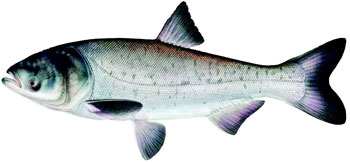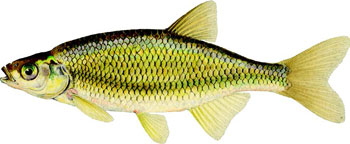Invasive carps
Invasive carps (formerly known as Asian carps)
In 2022, Ontario transitioned to using the term invasive carp to describe four invasive species of fish including bighead carp, silver carp, black carp, and grass carp. These four invasive carp species were formerly referred to as Asian carp.
Invasive carps were brought from Asia to North America in the 1960s and 70s. Since then they have migrated north through U.S. waterways towards the Great Lakes. Preventing invasive carps from spreading into the Great Lakes is the best way to prevent harm to Ontario’s native fish species.
Invasive carps (Silver carp, Bighead carp, Grass carp, Black carp):
- Are successful invaders that have replaced native species in areas of the Mississippi River and its tributaries
- Make up more than 50 per cent of the fish by weight in some parts of the Illinois River
- Can grow more than 25 centimetres in their first year
- Typically weigh two to four kilograms, but can weigh up to 40 kilograms and reach more than a metre in length
- Can eat up to 20 per cent of their body weight in plankton each day
- Reproduce rapidly.

MNR conservation officer seizes Bighead carp at Canada/U.S. border. Photo: MNR
Invasive carps threaten our native fishes and are a safety hazard
Invasive carps prefer cool to moderate water temperatures, like those found near the shores of the Great Lakes. If invasive carps become established in Ontario waters, they could potentially eat the food supply that our native fish depend on and crowd them out of their habitat. The decline of native fish species could damage sport and commercial fishing in Ontario, which brings millions of dollars a year into the province’s economy.

US Fish & Wildlife Service officer with Bighead carp from Illinois River. Photo: USFWS
The term “invasive carps” includes four species: Bighead, Silver, Grass and Black carp. Bighead carp and Silver carp are the species that have spread the most aggressively and can be considered one of the greatest threats to the Great Lakes.
Silver carp are a hazard for boaters. The vibration of boat propellers can make Silver carp jump up to three metres out of the water. Boaters and water-skiers in areas of the Mississippi and Illinois rivers have been seriously injured by jumping fish.

Silver carp jumping at Peoria Dam in Illinois. Photo: GLFC
What Ontario is doing
Ontario is working to keep new aquatic invaders like invasive carps out of the Great Lakes. We have made it illegal in Ontario to possess live Bighead, Silver, Grass or Black carp as well as other invasive fish species. People have been caught, convicted and received large fines for trying to import truckloads of live invasive carps into Ontario to sell at fish markets.
Enforcement of invasive species laws is the responsibility of conservation officers who work in cooperation with other agencies, such as the federal government, to stop the illegal movement of invasive species.
Ontario has partnered with the Ontario Federation of Anglers and Hunters since 1992 on programs to fight invasive species, including education, outreach and training; province-wide monitoring; and early detection.
Ontario has been working with our partners to test our state of readiness and develop a response plan for invasive carps. The plan will serve as a guide to taking action should a sighting of an invasive carp in the wild be confirmed.
How anglers can help:
- Don’t dump your bait! Always put unwanted baitfish in the garbage and empty bait bucket water on dry land. It is illegal to dump the contents of any bait container into the water or within 30 metres of any lake, pond, river or stream.
- Make sure you check your bait. As an angler, you are responsible for making sure you only possess species that may legally be used as bait – even if the bait came from a bait dealer. See Fishing.
- Learn to identify invasive carps. Don’t confuse young invasive carps with common Ontario species.

Bighead carp filter feeding on plankton. Photo: Kate Gardiner
How everyone can help:
- Don’t release any live fish into Ontario lakes or rivers.
- Don’t import live fish into Ontario.
- If you have any information about the illegal importing, distribution or sale of live invasive carps, report it immediately to the MNR TIPS line at
1-877-TIP-SMNR (847-7667) toll-free any time, or contact your local ministry office during regular business hours. You can also call Crime Stoppers anonymously at1-800-222-TIPS (8477) . - If you’ve seen an invasive carp or other invasive species in the wild please contact the toll free Invading Species Hotline at
1-800-563-7711 .
Learn to identify invasive carps
Bighead and Silver carp represent the most severe threat to Ontario waters.
Bighead carp:

- Typically two to four kilograms; up to 40 kilograms in weight and more than a metre in length
- Very large head and toothless mouth
- Adult fish are dark grey with dark mottling
- Eyes sit below the mouth

Bighead carp. Photo: Kate Gardiner
Silver carp:

- Smaller than Bighead carp
- Light silver in colour with a white belly
- Eyes sit below the mouth.

Bighead and Silver carp have large toothless mouths. Photo: MNR
Grass carp:

- Large scales that appear crosshatched
- Eyes sit even with the mouth.

Grass carp. Photo: Mike Correa, TRCA
Adult invasive carp illustrations – Joe Tomelleri
For more information:
- Invasive species in Ontario
- Ontario’s invading species awareness program
- Great Lakes Fishery Commission - invasive carp
- Fisheries and Oceans Canada - Centre of Expertise for Aquatic Risk Assessment
Don’t confuse young invasive carps with these common Ontario minnows
Juvenile invasive carps
Juvenile bighead carp

Colour/markings: Silvery, with dark mottling, especially on back
Mouth: Up-turned
Length: 5 to 10 centimetres
Keel (ridge on the underbelly): Prominent, extending from anal fin to pelvic fins (mid-body), no scales
Scales: Very small
Eyes: Below line extending from tail to snout (see dotted line above).
Juvenile silver carp

Colour/markings: Silvery, without dark mottling or coloration on back
Mouth: Upturned
Length: 5 to 10 centimetres
Keel (ridge on the underbelly): Prominent, extending from anal fin to gills, no scales
Scales: Very small
Eyes: Below line extending from tail to snout (see dotted line above).
Juvenile grass carp

Colour/markings: Pale grey to gold colour, scales show prominent dark edge, giving a cross-hatched appearance
Mouth: Terminal to slightly downturned
Length: 5 to 10 centimetres
Keel (ridge on the underbelly): Absent
Scales: Intermediate to large
Eyes: On line extending from tail to snout.
Juvenile invasive carp illustrations © Emily S. Damstra
Common minnows
Fallfish

Colour/markings: Back is dark olive-green, black or brown, sides are silvery, belly is silvery white
Length: 20 centimetres is common bait size
Keel (ridge on the underbelly): Absent
Scales: Intermediate to large with a dark crescent in front of each scale
Eyes: On line extending from tail to snout
Emerald shiner

Colour/markings: Silver with green iridescence
Length: 7.5 to 10 centimetres is common bait size
Keel (ridge on underbelly): Absent
Scales: Intermediate to large
Eyes: On line extending from tail to snout
Spottail shiner

Colour/markings: Silvery sides with greenish-blue back, prominent dark spot on tail
Length: 7.5 to 10 centimetres is common bait size
Keel (ridge on underbelly): Absent
Scales: Intermediate to large
Eyes: On line extending from tail to snout
Golden shiner

Colour/markings: Gold or brassy, deep-bodied with a lateral line running along the sides and dipping down in the middle of the body; silvery/black lateral stripe in juveniles
Length: 7.5 to 18 centimetres is common bait size
Keel (ridge on underbelly): Present, extending from anal fin to pelvic fins (mid-body), no scales; ridge is less distinct than alewife and invasive carps
Scales: Intermediate to large
Eyes: On line extending from tail to snout
Common minnow illustrations – Joe Tomelleri